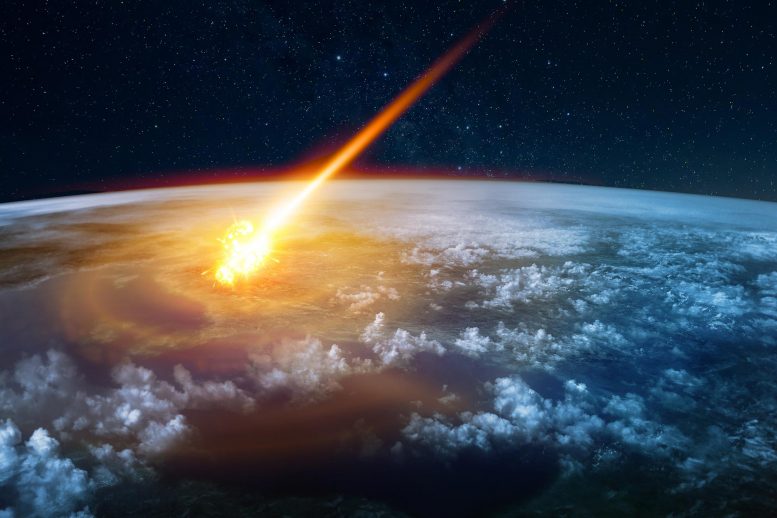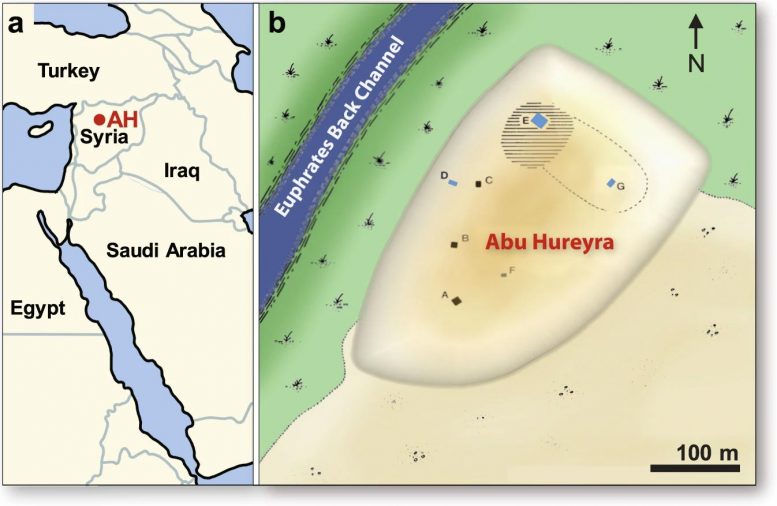
Evidence found by researchers indicates a cosmic impact caused the destruction of one of the world’s earliest human settlements.
Before the Taqba Dam impounded the Euphrates River in northern Syria in the 1970s, an archaeological site named Abu Hureyra bore witness to the moment ancient nomadic people first settled down and started cultivating crops. A large mound marks the settlement, which now lies under Lake Assad.
But before the lake formed, archaeologists were able to carefully extract and describe much material, including parts of houses, food, and tools — an abundance of evidence that allowed them to identify the transition to agriculture nearly 12,800 years ago. It was one of the most significant events in our Earth’s cultural and environmental history.
Abu Hureyra, it turns out, has another story to tell. Found among the cereals and grains and splashed on early building material and animal bones was meltglass, some features of which suggest it was formed at extremely high temperatures — far higher than what humans could achieve at the time — or that could be attributed to fire, lighting or volcanism.
“To help with perspective, such high temperatures would completely melt an automobile in less than a minute,” said James Kennett, a UC Santa Barbara emeritus professor of geology. Such intensity, he added, could only have resulted from an extremely violent, high-energy, high-velocity phenomenon, something on the order of a cosmic impact.

Location of Abu Hureyra (adapted from Moore et al.31. (a) Map of the Middle East, showing Abu Hureyra location (AH) in Syria. (b) Map of the Abu Hureyra tell, showing locations of excavation trenches labeled A-G near a back channel of Euphrates River that is now abandoned. Sediment samples from Trenches D, E, and G (blue rectangles) contain abundance peaks in YDB proxies, including spherules, nanodiamonds, meltglass, and platinum. Credit: Scientific Reports (2020). DOI: 10.1038/s41598-020-60867-w
Based on materials collected before the site was flooded, Kennett and his colleagues contend Abu Hureyra is the first site to document the direct effects of a fragmented comet on a human settlement. These fragments are all part of the same comet that likely slammed into Earth and exploded in the atmosphere at the end of the Pleistocene epoch, according to Kennett. This impact contributed to the extinction of most large animals, including mammoths, and American horses and camels; the disappearance of the North American Clovis culture; and to the abrupt onset of the end-glacial Younger Dryas cooling episode.
The team’s findings are highlighted in a paper published in the Nature journal Scientific Reports.
“Our new discoveries represent much more powerful evidence for very high temperatures that could only be associated with a cosmic impact,” said Kennett, who with his colleagues first reported evidence of such an event in the region in 2012.
Abu Hureyra lies at the easternmost sector of what is known as the Younger Dryas Boundary (YDB) strewnfield, which encompasses about 30 other sites in the Americas, Europe, and parts of the Middle East. These sites hold evidence of massive burning, including a widespread carbon-rich “black mat” layer that contains millions of nanodiamonds, high concentrations of platinum, and tiny metallic spherules formed at very high temperatures. The YDB impact hypothesis has gained more traction in recent years because of many new discoveries, including a very young impact crater beneath the Hiawatha Glacier of the Greenland ice sheet, and high-temperature meltglass and other similar evidence at an archaeological site in Pilauco, located in southern Chile.
“The Abu Hureyra village would have been abruptly destroyed,” Kennett said. Unlike the evidence from Pilauco, which was limited to human butchering of large animals up to but not younger than the YDB impact burn layer, Abu Hureyra shows direct evidence of the disaster on this early human settlement. An impact or an airburst must have occurred sufficiently close to send massive heat and molten glass over the entire early village, Kennett noted.
The glass was analyzed for geochemical composition, shape, structure, formation temperature, magnetic characteristics, and water content. Results from the analysis showed that it formed at very high temperatures and included minerals rich in chromium, iron, nickel, sulfides, titanium, and even platinum — and iridium-rich melted iron — all of which formed in temperatures higher than 2,200 degrees Celsius (,000 degrees Fahrenheit).
“The critical materials are extremely rare under normal temperatures, but are commonly found during impact events,” Kennett said. According to the study, the meltglass was formed “from the nearly instantaneous melting and vaporization of regional biomass, soils, and floodplain deposits, followed by instantaneous cooling.” Additionally, because the materials found are consistent with those found in the YDB layers at the other sites across the world, it’s likely that they resulted from a fragmented comet, as opposed to impacts caused by individual comets or asteroids.
“A single major asteroid impact would not have caused such widely scattered materials like those discovered at Abu Hureyra,” Kennett said. “The largest cometary debris clusters are proposed to be capable of causing thousands of airbursts within a span of minutes across one entire hemisphere of Earth. The YDB hypothesis proposed this mechanism to account for the widely dispersed coeval materials across more than 14,000 kilometers (8,700 miles) of the Northern and Southern Hemispheres. Our Abu Hureyra discoveries strongly support a major impact event from such a fragmented comet.”
Reference: “Evidence of Cosmic Impact at Abu Hureyra, Syria at the Younger Dryas Onset (~12.8 ka): High-temperature melting at >2200 °C” by Andrew M. T. Moore, James P. Kennett, William M. Napier, Ted E. Bunch, James C. Weaver, Malcolm LeCompte, A. Victor Adedeji, Paul Hackley, Gunther Kletetschka, Robert E. Hermes, James H. Wittke, Joshua J. Razink, Michael W. Gaultois and Allen West, 6 March 2020, Scientific Reports.
DOI: 10.1038/s41598-020-60867-w
Research on this study was conducted also by Andrew Moore, from the Rochester Institute of Technology in New York; William M. Napier, from the Armagh Observatory and Planetarium in Norther Ireland; Ted E. Bunch and James H. Wittke, from Northern Arizona University; James C. Weaver, from Harvard University; Malcolm LeCompte and A. Victor Adedji, from Elizabeth State University in North Carolina; Paul Hackley, from the United States Geological Survey; Gunther Kletetschka, from the Czech Academy of the Sciences, Charles University in the Czech Republic and University of Alaska; Robert E. Hermes, from Los Alamos National Laboratory (retired); Joshua J. Razink from the University of Oregon; Michael Willam Gaultois, from the University of Liverpool in the UK; and Allen West, from the Comet Research Group in Arizona.









It may be that during this epoch when agriculture was planted alongside beer-making that the patriarch Noah can be represented, particularly the description of his birth in the 106th chapter of the Ethiopian book of Enoch and whose body is described as being white as snow and red as rose not unlike a comet breaking into fragments and descending to earth. The house became bright when the heavenly being opened it’s eyes; the moment of impact.
This also seems similar to the stories of Sodom and Gomorrah. While this doesn’t “prove” the biblical implications, it hints at how the “stories” could have been passed down over Millennia eventually having “spiritual” explanations for such a “heavenly” event.
Hence the description of angels in the Old and New Testament scripture are likely based on cosmic events. Perhaps the story about the Cities of the Plain north of the Dead Sea that fall within the boundaries of Canaan are part of a local tradition that was inherited from previous cultures on the eastern end of the Younger Dryas impact area. The Genesis narrative places the Sodom and Gomorrah event against the backdrop of the covenant of the Lord which conforms to the political status of the chief city of the central highlands of Canaan, Shechem, whose chief deity was Baal Brit, or Lord of the Covenant. Noah is likely a local figure as well with evidence of beer processing from grains in a cave near Haifa, Israel about the outset of the Younger Dryas event.
The Cycle of Cosmic Catastrophes by Firestone, et al.
This fringe hypothesis again? And may I first say that I find the religious (so wrong) responses of further pattern search hilarious in that respect.
This particular impact hypothesis is so tedious, the fringe group behind it is looking everywhere for putative impact residues – which never are, but are remains from natural or human wood fires – and impact sites – which have undecided dates. For example, there is no accepted strewn field [ https://en.wikipedia.org/wiki/Younger_Dryas_impact_hypothesis%5D, the Greenland crater is at least 50 kyrs old [ https://en.wikipedia.org/wiki/Hiawatha_Glacier ], the Clovis culture changes have been explained by gene flow as everywhere else and the megafauna extinctions spread over time [ 1st link].
There is no reference to Abu Hureyra dating in the paper, and its occupancy ages are also spread over time. The depopulation of hunter-gatherers are coeval with extensive drought during the Younger Dryas period [ https://en.wikipedia.org/wiki/Tell_Abu_Hureyra ]. A convenient choice for a fringe hypothesis, the site is now drowned.
The site of Gobekly Tepe has a reference to this cataclysmic event recorded a millennia after:
http://www.ancient-origins.net/artifacts-other-artifacts/cataclysmic-0011799
This is rich material for those looking for the steles of the Sethian people who, according to Josephus, were established in the land of Syriad, which makes the site of Abu Hureyra is a candidate.
https://www.ancient-origins.net/artifacts-other-artifacts/cataclysmic-0011799
Huh!
The nay sayers whole educational response is tied up in that great guardian in the sky wiki who any who.
https://www.ancient-origins.net/artifacts-other-artifacts/cataclysmic-0011799
https://www.ancient-origins.net/artifacts-other-artifacts/cataclysmic